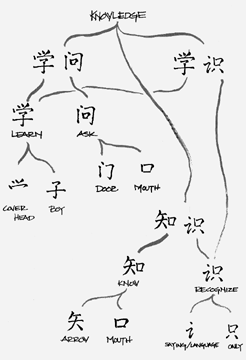How Do We Mean?
Jixuan Hu
Paul Pangaro
Xiaoyun Sun
This piece was originally published in "26", a publication
of AGFA Corporation in 1992 that was conceived and designed by
the designer Bruce Macintosh, who solicited a wide variety of
works from graphic designers, writers, and photographers from
around the world.
The text below was overlaid in thin columns on two 11"x17"
pages that contained the Chinese pictograms shown in the thumbnails
above. Larger versions of the pages are available here by clicking
on the thumbnails.
How do we mean?
A scratch, a mark, a symbol; a recognition; a meaning.
We forget how we got here * from there. It is a long way back, after all.
With our precious alphabet of "26", we do not see each mark; we grab the words "whole hog", and make the meaning. We even forget that behind the words are origins that help bring forth that meaning. When we say we "understand" something, we forget how that comes from saying we can "stand-under" it.
Even that relatively short distance, just to the roots of our words, is one we can't consciously travel every time we write. It is of course un-reasonable to want to simultaneously markdown both what we now mean and how we have come to mean it. We have enough to do in agreeing about what means what (more or less).
But it is cleansing to re-fresh our-selves with origins, whether our own or our neighbors'. Here we de-compose the pictograms of some Chinese words and map them into English, to re-expose their "roots" and invite similar revelations about our "26"-based tongues. This exercise cannot be precise, and it blurs distinctions between true Chinese words and the more ancient pictures that compose them.
We have chosen the domain of knowing and the construction of meaning as a focus for our excursion: concepts such as "idea", "knowledge", "understanding", "reality". Note that sometimes more than one Chinese word maps into a single English word, and vice versa, losing nuances in the process. But we emphasize that self-reflection, rather than precise archae-ology, is our intention. To share the wonder of how layers and textures arise, and how we come to dance in agreement with them, is our reward.
Any good diction-ary can start this process for any tongue, and we invite the contributions of our readers to continue the dancing.
-end-
© Copyright Paul Pangaro 1994 - 2000. All Rights Reserved.

